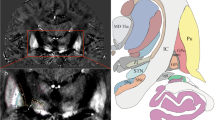Summary
We evaluated the direct location in the globus pallidus (GP) under stereotactic MRI (sMRI) guidance in five parkinsonians treated with chronic deep brain stimulation (four bilaterally). The sMRI consisted of three orthogonal (horizontal, frontal, sagittal) sets of images obtained with a stereotactic frame and its localiser. The sMRI was coupled with ventriculography to compare the location with the classic indirect method based on commissural landmarks. The target was defined on T2-weighted slices in the anterior part of the medial GP, at the vertex of the nucleus. It was reached via one track with a semi-micro-electrode and step by step high frequency stimulation, then replaced by a quadripolar electrode once we located the site enabling the optimal clinical improvement. Stereotactic x-rays localised the final position of the electrode. A company software matched sMRI, ventriculography, and peroperative (perop) x-rays, with reference to the stereotactic location boxes. We analysed the effects of acute (perop) and chronic (six-month follow-up) stimulation of active plots (acplots), i.e. leading to optimal clinical improvement. Three distances with reference to the acplots were measured both on sMRI and ventriculography: the laterality from the median sagittal plane of the third ventricle; the anterior position from the midpoint of the intercommissural line (Icl), and the vertical position with regard to the Icl. We then compared the differences in measurements (n=64) with the Bland and Altman method. The mean difference was 0.09 mm with 95% of the values between ±1 mm, but only the laterality had a statistically significant agreement (all the differences included between ± two times the standard deviation of the mean). The acplots distances from the dorsal, ventral, and medial boundaries of GP (defined by manual surrounding on frontal and horizontal planes) were measured on sMRI. With one exception, the acplots were all included in the nucleus. The six-month acplots were located dorsally with reference to the perop ones. Clinical benefit at six-months follow-up showed results comparable to the literature. Direct location of GP target based on sMRI seems a simple and reliable method.
Similar content being viewed by others
Author information
Authors and Affiliations
Rights and permissions
About this article
Cite this article
Lemaire, J., Durif, F., Boire, J. et al. Direct Stereotactic MRI Location in the Globus Pallidus for Chronic Stimulation in Parkinson's Disease. Acta Neurochir (Wien) 141, 759–766 (1999). https://doi.org/10.1007/s007010050372
Issue Date:
DOI: https://doi.org/10.1007/s007010050372




